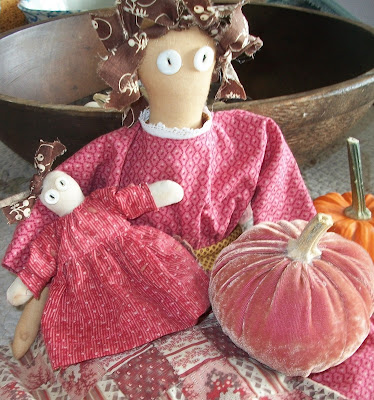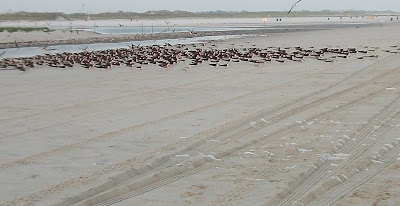The brisk, clear October winds have brought the songbirds to the Beach. My holly bushes are busy with activity! Gangs of tiny warblers, mostly "Yellow-Rumped"---sparrow-like, each with big yellow coin dot on its back. More rare are the kinglets, the flycatchers, the black and white warblers. The skies over the marshes are filled with clouds of blackbirds and starlings and the egrets huddle together like mournful ghosts among the phragmite reeds. If I look up high I see Vs of geese, migratory Canada geese and a rare sighting now and then of snow geese or huge white swans. And perhaps a hawk or tow will pass by, enticed by bountiful fish and game. The small mallard flock has returned to the swale. It's pretty dry, slim snacking for my ducks this year....

The piping plovers leave as soon as their babies can fly. They are gone by late July. The first flocks of shorebirds to gather and go are the assorted terns, in mid-September. Good riddance as they are aggressive fighters, scary when they attack the innocent beachgoers, including me!
One evening, mid-September, we had a huge flock of migrating gulls fly through. They passed by the Beach at sunset, following a
dragonfly migration, it seemed.
The gulls were not our local gulls; they were smaller and very white with black heads and grey wings.
Possibly Bonaparte gulls, because the black head caps were small-ish; or the more common, though rare here, laughing gull. Thousands of them filled the sky!
My beloved oystercatchers slip away by October first, leaving in pairs and threesomes...just as they arrived on St Patrick's Day in March.
The first group of Black Skimmers leaves at the same time.
They surely number in the thousands, tens of thousands?
A second group, whose babies were still unfledged by Oct 2 (I accidentally invaded their nesting ground while beachcombing! So sad, the big babies scurry away, cannot yet fly!)---that group lingers until later in October, but they have now gone too.
This was a small busy batch of Wilson's plovers [below]. They stayed a week or so, then moved on.
And the incredible flocks of sanderlings come and go, feeding and fattening for their flight to the Antarctic!
I believe they fly the farthest of almost any birds, nesting in the Arctic North, wintering in the Antarctic. I always wonder what makes them move on? Why fly so far, when there is plenty of food here (tiny sea creatures in the surf) and the winters cannot be any colder than their own?
And last, the butterflies and dragonflies. Amazing that they to go so far.
The
monarchs arrive as soon as the
goldenrod begins to bloom on the dunes.
I know they lay their eggs on only milkweed and that their caterpillars feed on the milkweed. But the migrating adults seem very happy to stop and sun on the Beach,
...then slowly flutter up to the dunes to rest and refresh, to fill themselves with goldenrod nectar.
They always seem so tired, poor things....Mexico must seem very far to a creature so tiny.
My parents in Cape Cod used to see tiny flocks of hummingbirds pass through! How I'd love to see them! I grew a special red-flowering vine for them [mandevillea]...but, no. Not yet.
Late fall and winter will bring more shorebirds, different types: pipers and plovers; sea ducks, loons and geese. Even some seals? A whale? And it seems my little friend here will stay on, waiting for
someone! anyone! to bring him a meal.
love
lizzy
......gone to the beach
PS: a rare autumn rainbow....promising good times ahead?























.jpg)














































.jpg)














